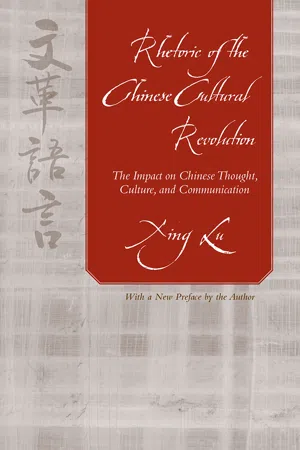
Rhetoric of the Chinese Cultural Revolution
The Impact on Chinese Thought, Culture, and Communication
- 270 pages
- English
- PDF
- Available on iOS & Android
Rhetoric of the Chinese Cultural Revolution
The Impact on Chinese Thought, Culture, and Communication
About This Book
A startling look at revolutionary rhetoric and its effects
Now known to the Chinese as the "ten years of chaos, " the Chinese Cultural Revolution (1966–76) brought death to thousands of Chinese and persecution to millions. In Rhetoric of the Chinese Cultural Revolution Xing Lu identifies the rhetorical practices and persuasive effects of the polarizing political language and symbolic practices used by Communist Party leaders to legitimize their use of power and violence to dehumanize people identified as class enemies.
Lu provides close readings of the movement's primary texts—political slogans, official propaganda, wall posters, and the lyrics of mass songs and model operas. She also scrutinizes such ritualistic practices as the loyalty dance, denunciation rallies, political study sessions, and criticism and self-criticism meetings. Lu enriches her rhetorical analyses of these texts with her own story and that of her family, as well as with interviews conducted in China and the United States with individuals who experienced the Cultural Revolution during their teenage years.
In her new preface, Lu expresses deep concern about recent nationalism, xenophobia, divisiveness, and violence instigated by the rhetoric of hatred and fear in the United States and across the globe. She hopes that by illuminating the way language shapes perception, thought, and behavior, this book will serve as a reminder of past mistakes so that we may avoid repeating them in the future.
Frequently asked questions
Information
Table of contents
- Cover
- Rhetoric of the Chinese Cultural Revolution
- Title
- Copyright
- Dedication
- Contents
- Series Editor’s Preface
- Preface to the Paperback Edition
- Preface to the First Edition
- Introduction
- Chapter One My Family Caught in the Cultural Revolution
- Chapter Two Language, Thought, and Culture in the Chinese Political Context
- Chapter Three A Rhetorical Analysis of Political Slogans
- Chapter Four A Rhetorical Analysis of Wall Posters
- Chapter Five A Rhetorical Analysis of Revolutionary Songs and Model Operas
- Chapter Six A Rhetorical Analysis of Political Rituals
- Chapter Seven A Rhetorical Analysis of Post–Cultural Revolution Political Discourse
- Chapter Eight Conclusion and Implications
- Notes
- Bibliography
- Chinese Names and Terms Index
- General Index